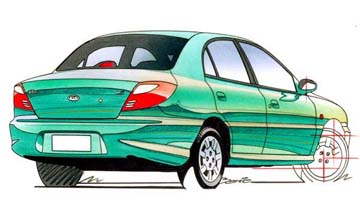BY MALCOLM LIVERMORE | 12th Apr 2001

Tens of thousands of small Kias have been sold in Australia over the past few years, badged as Ford Fiestas, now the South Korean factory is going to keep the new Rio under its own banner, while expanding its range and aggressively chasing sales in several segments.
As on most cars, opening the door of the Rio after a few hours of standing locked-up released a smell from the cabin's fabrics, plastics and adhesives.
However, the Rio's was unusual and the best way to describe it would be "morning after a bush-fire" It goes away within minutes and is not particularly objectionable, just unusual.
Most of the rest of the car is satisfactory with peppy performance, a high specification level, good cabin space and adequate handling and brakes complementing neat styling and a surprisingly high build quality.
Body styling cues seem to be part-modern, in the shapely front end with its under-bumper air-dam and in part a repeat of the bubble-backed Mazda 121.
Both ends of the sedan are dominated by large, bright lamp-clusters but there is almost no brightwork, apart from a thin chromed strip above the grille - and all parts, including rubbing strip, bumper bars, mirrors and door handles, are body-coloured. Metallic paint is a $150 option.
The rear doors arc down towards the back and can make bumped heads a common occurrence when lifting children in and out, although once seated, occupants found headroom was generous and visibility good.
In addition, the boot aperture is small, so although the boot deck rises vertically, and the cavern can contain 261 litres of luggage, it better be in small boxes just to get it in. The hatch-backed, five-door version obviously does not have this problem.
Interior space is good in the front, fair in the back, as long as the front row passengers do not have long legs the middle passenger in the back seat gets only a lap-belt.
Inside, the fit, finish and trim are up to the standards of more expensive Japanese and European cars, with controls well placed the steering column does not adjust but standard equipment includes a driver's airbag, power steering, air-conditioning and an in-dash radio/CD player. Mirrors and windows are manually adjusted.
The standard radio unit is awful, with tiny, fiddly little buttons that are hard to find when parked, let alone while on the move. AM station reception is less than ordinary and this unit lets down what is otherwise a competent dash layout.
The clutch and gearshift actions are light and positive, although the gear lever vibrates excessively, making sure you do not rest your hand on it for longer than you need to.
There is good space in the footwell and the car was easy to drive, although enthusiastic drivers will find the ride mushy and the handling uninspiring.
In suburban driving, which is where most Rios will see most action, the car goes where it is pointed with minimal aggravation.
But at highway speeds the Rio feels light on its wheels and gets pushed about by wind-blast from prime-movers and busses.
At much over 100km/h the engine noise and vibration begin to get intrusive.
Driven with gusto, the steering becomes vague and detached, offering little feedback to the driver. The ride is unrefined in that coarse road surfaces make themselves heard and damping of bumps is unremarkable.
Under the bonnet, power comes from a four-cylinder, 1500cc engine driving the front wheels through a five-speed gearbox.
Power is claimed to be a respectable 73.5kW at 5800rpm but the engine is coarse, noisy and breathless much beyond the mid-range. Maximum torque of 135Nm is claimed at 4500rpm, which is about as high as you would want to rev it anyway.
Kia has fitted the Rio with novel air-filled crash bladders in the crumple zones which absorb impact in the event of a bingle, or progressively burst in something more serious.
Ford wanted the Kia Rio to be the car to replace the Fiesta - Ford failed to get it and only Kia will sell the Rio. For first-time new-car buyers or people to whom the driving experience is not especially important, the South Korean offering represents a serious alternative to much more basic Japanese or expensive European cars.
- Automotive NetWorks 5/10/2000